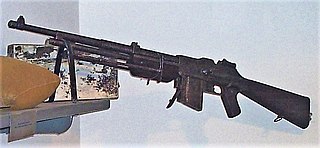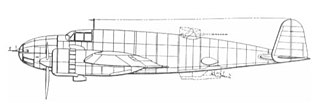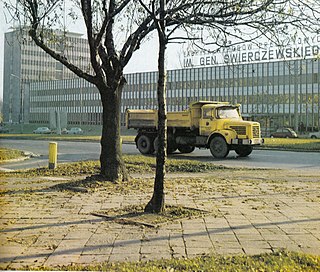
The PZL P.11 was a Polish fighter aircraft, designed and constructed during the early 1930s by Warsaw-based aircraft manufacturer PZL. Possessing an all-metal structure, metal-covering, and high-mounted gull wing, the type held the distinction of being widely considered to have briefly been the most advanced fighter aircraft of its kind in the world.

The PZL P.7 was a Polish fighter aircraft designed in the early 1930s at the PZL factory in Warsaw. It was one of the first all-metal monoplane fighters in the world and was the main fighter of the Polish Air Force between 1933 and 1935. The PZL P.7 was replaced in Polish service by its follow-up design, the PZL P.11c. More than 30 PZL P.7 fighters remained in service during the Invasion of Poland, scoring several kills despite its obsolescence.

Karabin przeciwpancerny wzór 35 was a Polish 7.9 mm anti-tank rifle used by the Polish Army during the 1939 Invasion of Poland. It was also known by its codename Uruguay, after that country, and by the name of its designer, Józef Maroszek.

The LWS-3 Mewa ("Seagull") was a Polish observation and close reconnaissance aircraft, designed in the late-1930s by the LWS factory. It was ordered by the Polish Air Force, but did not manage to enter service before the outbreak of World War II.

The Zakłady Mechaniczne "Tarnów" UKM-2000 is a 7.62×51mm NATO general-purpose machine gun designed in Tarnów, Poland.

The Browning wz.1928 is a Polish version of the M1918 BAR. It was a light machine gun used by the Poles in World War II.

Ckm wz. 30 is a Polish-made clone of the American Browning M1917 heavy machine gun. Produced with various modifications such as greater caliber, longer barrel and adjustable sighting device, it was an improved although unlicensed copy of its predecessor, and was the standard machine gun of the Polish Army since 1931.
Karabin wzor 98a was a Polish derivative of the German Gewehr 98 bolt-action rifle.

PZL.46 Sum (sheatfish) was a light bomber of the Polish Air Force before World War II, which, was directed to serial production in the spring of 1939. These planes were in production, but the Polish industry did not manage to produce them before the outbreak of the war.

The PZL.38 Wilk (wolf) (PZL-38) was a Polish fighter-bomber developed and manufactured by PZL state factory in 1937.

The PZL.43 was a Polish light bomber and reconnaissance aircraft designed in the mid-1930s by PZL in Warsaw. It was an export development of the PZL.23 Karaś. Its main user was the Bulgarian Airforce who called it the Chaika.
The PZL.48 Lampart (leopard) was a Polish heavy fighter-bomber design, that remained only a project, owing to the outbreak of World War II.
The karabin maszynowy obserwatora wz.37 is a Polish version of the Browning wz.1928. It was a flexible machine gun used in the some Polish airplanes in the beginning of World War II.

The PZL.49 Miś (English:Bear) was a Polish twin-engined medium bomber design that remained only a project due to the outbreak of World War II. The PZL.49 was based on the contemporary PZL.37 Łoś and was to replace it at production lines at the PZL works.

The Nkm wz.38 FK was a 20 mm heavy machine gun produced in inter-war Poland. It was used both in anti-air and anti-tank role and was also adapted for tank use and mounted on some TKS tankettes. Mass-produced in 1938 and 1939, it was used extensively during the September Campaign.
The PZL.3 was a Polish project for a four-engine heavy bomber, designed by Władysław Zalewski from 1928-1930 at PZL.

Państwowa Fabryka Karabinów was a Polish arms manufacturer active between the two World Wars. Founded in 1919 as the successor to the pre-World War I Gerlach i Pulst company, Fabryka Karabinów became part of the state-owned Państwowe Wytwórnie Uzbrojenia conglomerate in 1927. It was a sister company to Łucznik Arms Factory, the Munitions Factory of Skarżysko, and several others. By the end of the 1930s, Fabryka Karabinów was one of the largest arms producers of Poland. It was destroyed during World War II.

The Ciężki karabin maszynowy wz. 25 Hotchkiss was a Polish derivative of the Hotchkiss M1914 machine gun, rechambered for 7.92×57mm Mauser ammunition.














